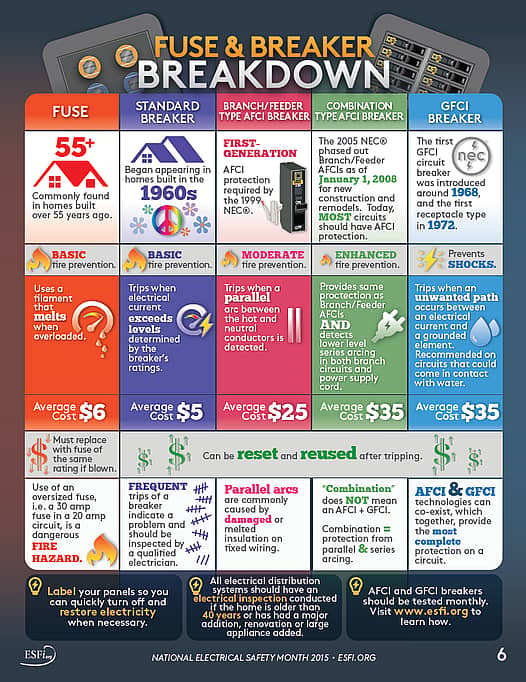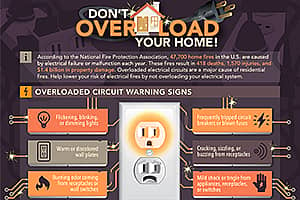National Electrical Safety Month 2015
Do you know what’s inside your electrical service panel? Fuses and circuit breakers protect an overloaded electrical circuit by interrupting the flow of electricity, but there are many variations that offer different levels of protection. This Fuse and Breaker Breakdown will help determine what you have in your home, and whether or not you should consider consulting an electrician for an upgrade.
FUSE |
STANDARD BREAKER |
BRANCH/FEEDER TYPE AFCI BREAKER |
COMBINATION TYPE AFCI BREAKER |
GFCI BREAKER |
| Commonly found in homes built over 55 years ago | Began appearing in homes built in the 1960’s | First-generation AFCI protection required by the 1999 NEC | The 2005 NEC phased out Branch/Feeder AFCIs as of January 1, 2008 for new construction and remodels. Today most circuits should have AFCI protection | The first GFCI breaker was introduced around 1968 and the first receptacle type in 1972 |
| Basic Fire Prevention | Basic Fire Prevention | Moderate Fire Prevention | Enhanced Fire Prevention | Prevents Shocks |
| Uses a filament that melts when overloaded | Trips when an electrical current exceeds levels determined by the breaker’s ratings. | Trips when a parallel arc between the hot and neutral conductors is detected | Provides same protection as Branch/Feeder AFCIs and detects lower level series arcing in both branch circuits and power supply cords | Trips when an unwanted path occurs between an electrical current and a grounded element. Recommended on circuits that could come in contact with water |
| Must replace with fuse of the same rating if blown | Can be reset and reused after tripping | |||
| Use of an oversized fuse, i.e. a 30 amp fuse in a 20 amp circuit is a dangerous fire hazard | Frequent trips of a breaker indicate a problem and should be inspected by a qualified electrician | Parallel arcs are commonly caused by damaged or melted insulation on fixed wiring | “Combination” does not mean AFCI+ GFCI. Combination equals protection from parallel & series arcing | AFCI and GFCI technologies can co-exist, which together, provide the most complete protection on a circuit |
Label your panels so you can quickly turn off an restore electricity when necessary
All electrical distribution systems should have an electrical inspection conducted if the home is older than 40 years or has had a major addition, renovation, or large appliance added.






